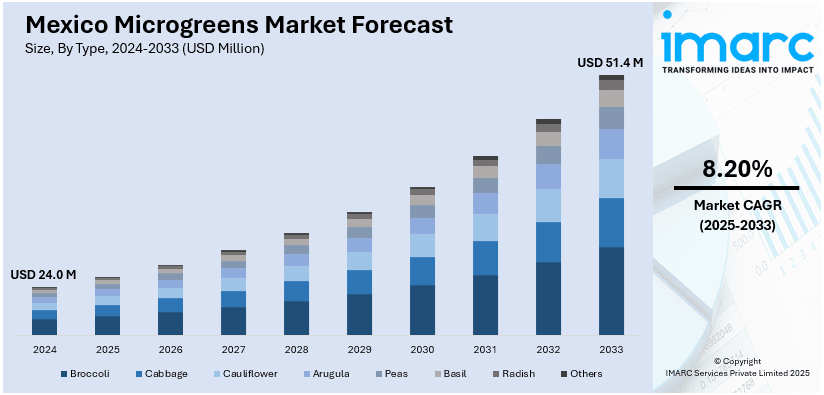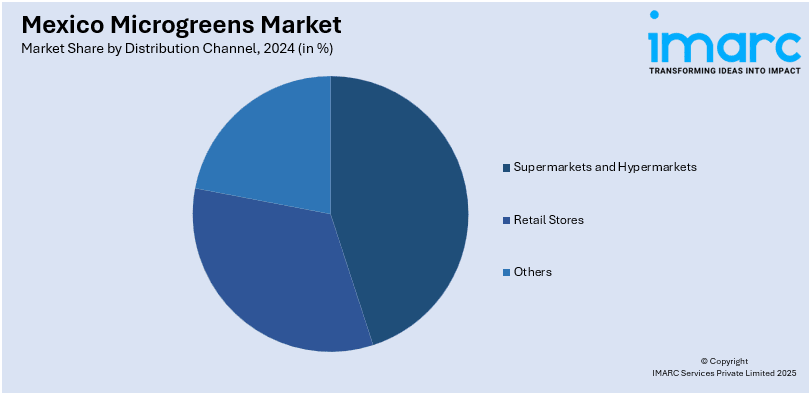
Mexico Microgreens Market Size, Share, Trends and Forecast by Type, Farming Method, Distribution Channel, End Use, and Region, 2025-2033
Mexico Microgreens Market Overview:
The Mexico microgreens market size reached USD 24.0 Million in 2024. Looking forward, IMARC Group expects the market to reach USD 51.4 Million by 2033, exhibiting a growth rate (CAGR) of 8.20% during 2025-2033. Growing health consciousness and demand for nutrient-rich superfoods are key drivers. Urbanization, gourmet dining trends, and sustainable farming practices further enhance demand. Expansion of retail and online distribution channels improves accessibility, while government support for organic farming encourages production. Rising disposable incomes and digital marketing are also augmenting the Mexico microgreens market share.
|
Report Attribute
|
Key Statistics
|
|---|---|
|
Base Year
|
2024 |
|
Forecast Years
|
2025-2033
|
|
Historical Years
|
2019-2024
|
| Market Size in 2024 | USD 24.0 Million |
| Market Forecast in 2033 | USD 51.4 Million |
| Market Growth Rate 2025-2033 | 8.20% |
Mexico Microgreens Market Trends:
Accelerating Demand for Organic and Locally-Sourced Microgreens
The market is experiencing significant growth due to increasing consumer preference for organic and locally-sourced produce. In 2023, Mexico authorized 571,608 hectares for organic agriculture, of which 60% are for wild harvesting, and 40% are for crops produced on farms. The top crop was coffee, on 88,173 hectares, followed by oranges, mangoes and lemons. 46,030 certified organic plant producers, mainly small indigenous coffee farmers and beekeepers, represented the bulk of the organic animal sector. This trend reflects a significant growth opportunity for the premium organic market here in Mexico, especially for certain micro-scale crops, including microgreens. Health-conscious consumers are seeking nutrient-dense superfoods, and microgreens packed with vitamins, minerals, and antioxidants are gaining popularity. Urbanization and the rise of gourmet restaurants are further propelling the Mexico microgreens market growth, as chefs incorporate microgreens into high-end dishes for enhanced flavor and presentation. Additionally, the shift toward sustainable farming practices has encouraged small-scale farmers to adopt hydroponic and vertical farming techniques, ensuring year-round production with minimal environmental impact. Government initiatives promoting organic farming and food security are also supporting market expansion. As more Mexicans prioritize wellness and sustainable eating, the demand for fresh, pesticide-free microgreens is expected to rise, creating opportunities for local growers and retailers to capitalize on this trend.

Expansion of Online Distribution Channels
The market is benefiting from the rapid expansion of retail and online distribution channels. A research report from the IMARC Group indicates that the retail market in Mexico achieved a size of USD 454.5 Billion in 2024. It is projected to grow to USD 693.0 Billion by 2033, reflecting a compound annual growth rate (CAGR) of 4.56% from 2025 to 2033. Supermarkets, health food stores, and farmers' markets are increasingly stocking microgreens to meet consumer demand for fresh, premium produce. Meanwhile, e-commerce platforms and subscription-based delivery services are making microgreens more accessible to urban households. This shift is driven by busy lifestyles and the growing preference for convenient, healthy food options. Social media and digital marketing have also played a crucial role in raising awareness about the nutritional benefits of microgreens, attracting younger consumers. Additionally, partnerships between microgreen producers and meal kit services are creating a positive Mexico microgreens market outlook. As digital adoption increases and supply chains improve, online sales of microgreens are projected to grow, providing a scalable avenue for producers to reach a wider customer base across Mexico.
Mexico Microgreens Market Segmentation:
IMARC Group provides an analysis of the key trends in each segment of the market, along with forecasts at the country level for 2025-2033. Our report has categorized the market based on type, farming method, distribution channel, and end use.
Type Insights:
- Broccoli
- Cabbage
- Cauliflower
- Arugula
- Peas
- Basil
- Radish
- Others
The report has provided a detailed breakup and analysis of the market based on the type. This includes broccoli, cabbage, cauliflower, arugula, peas, basil, radish, and others.
Farming Method Insights:
- Indoor Vertical Farming
- Commercial Greenhouses
- Others
A detailed breakup and analysis of the market based on the farming method have also been provided in the report. This includes Indoor vertical farming, commercial greenhouses, and others.
Distribution Channel Insights:

- Supermarkets and Hypermarkets
- Retail Stores
- Others
The report has provided a detailed breakup and analysis of the market based on the distribution channel. This includes supermarkets and hypermarkets, retail stores, and others.
End Use Insights:
- Residential
- Commercial
A detailed breakup and analysis of the market based on the end use have also been provided in the report. This includes residential and commercial.
Regional Insights:
- Northern Mexico
- Central Mexico
- Southern Mexico
- Others
The report has also provided a comprehensive analysis of all the major regional markets, which include Northern Mexico, Central Mexico, Southern Mexico, and Others.
Competitive Landscape:
The market research report has also provided a comprehensive analysis of the competitive landscape. Competitive analysis such as market structure, key player positioning, top winning strategies, competitive dashboard, and company evaluation quadrant has been covered in the report. Also, detailed profiles of all major companies have been provided.
Mexico Microgreens Market News:
- February 04, 2025: The College of Southern Maryland announced a vertical farming course to begin in Fall 2024, which stemmed from a grant worth USD 490,000 from the Tri-County Council for Southern Maryland and a 10-rack agricultural system acquired by Karma Verde Fresh of Mexico. This course enables students to cultivate 10 to 20 times more produce while utilizing 95% less water, allowing them to investigate sustainable methods for growing pesticide-free crops such as microgreens. This pioneering approach to introducing scalable solutions could transform the microgreens industry in Mexico for the growing demand for food.
Mexico Microgreens Market Report Coverage:
| Report Features | Details |
|---|---|
| Base Year of the Analysis | 2024 |
| Historical Period | 2019-2024 |
| Forecast Period | 2025-2033 |
| Units | Million USD |
| Scope of the Report |
Exploration of Historical Trends and Market Outlook, Industry Catalysts and Challenges, Segment-Wise Historical and Future Market Assessment:
|
| Types Covered | Broccoli, Cabbage, Cauliflower, Arugula, Peas, Basil, Radish, Others |
| Farming Methods Covered | Vertical Farming, Commercial Greenhouses, Others |
| Distribution Channels Covered | Supermarkets and Hypermarkets, Retail Stores, Others |
| End Uses Covered | Residential, Commercial |
| Regions Covered | Northern Mexico, Central Mexico, Southern Mexico, Others |
| Customization Scope | 10% Free Customization |
| Post-Sale Analyst Support | 10-12 Weeks |
| Delivery Format | PDF and Excel through Email (We can also provide the editable version of the report in PPT/Word format on special request) |
Key Questions Answered in This Report:
- How has the Mexico microgreens market performed so far and how will it perform in the coming years?
- What is the breakup of the Mexico microgreens market on the basis of type?
- What is the breakup of the Mexico microgreens market on the basis of farming method?
- What is the breakup of the Mexico microgreens market on the basis of distribution channel?
- What is the breakup of the Mexico microgreens market on the basis of end use?
- What is the breakup of the Mexico microgreens market on the basis of region?
- What are the various stages in the value chain of the Mexico microgreens market?
- What are the key driving factors and challenges in the Mexico microgreens market?
- What is the structure of the Mexico microgreens market and who are the key players?
- What is the degree of competition in the Mexico microgreens market?
Key Benefits for Stakeholders:
- IMARC’s industry report offers a comprehensive quantitative analysis of various market segments, historical and current market trends, market forecasts, and dynamics of the Mexico microgreens market from 2019-2033.
- The research report provides the latest information on the market drivers, challenges, and opportunities in the Mexico microgreens market.
- Porter's five forces analysis assist stakeholders in assessing the impact of new entrants, competitive rivalry, supplier power, buyer power, and the threat of substitution. It helps stakeholders to analyze the level of competition within the Mexico microgreens industry and its attractiveness.
- Competitive landscape allows stakeholders to understand their competitive environment and provides an insight into the current positions of key players in the market.
Need more help?
- Speak to our experienced analysts for insights on the current market scenarios.
- Include additional segments and countries to customize the report as per your requirement.
- Gain an unparalleled competitive advantage in your domain by understanding how to utilize the report and positively impacting your operations and revenue.
- For further assistance, please connect with our analysts.
 Request Customization
Request Customization
 Speak to an Analyst
Speak to an Analyst
 Request Brochure
Request Brochure
 Inquire Before Buying
Inquire Before Buying




.webp)




.webp)












